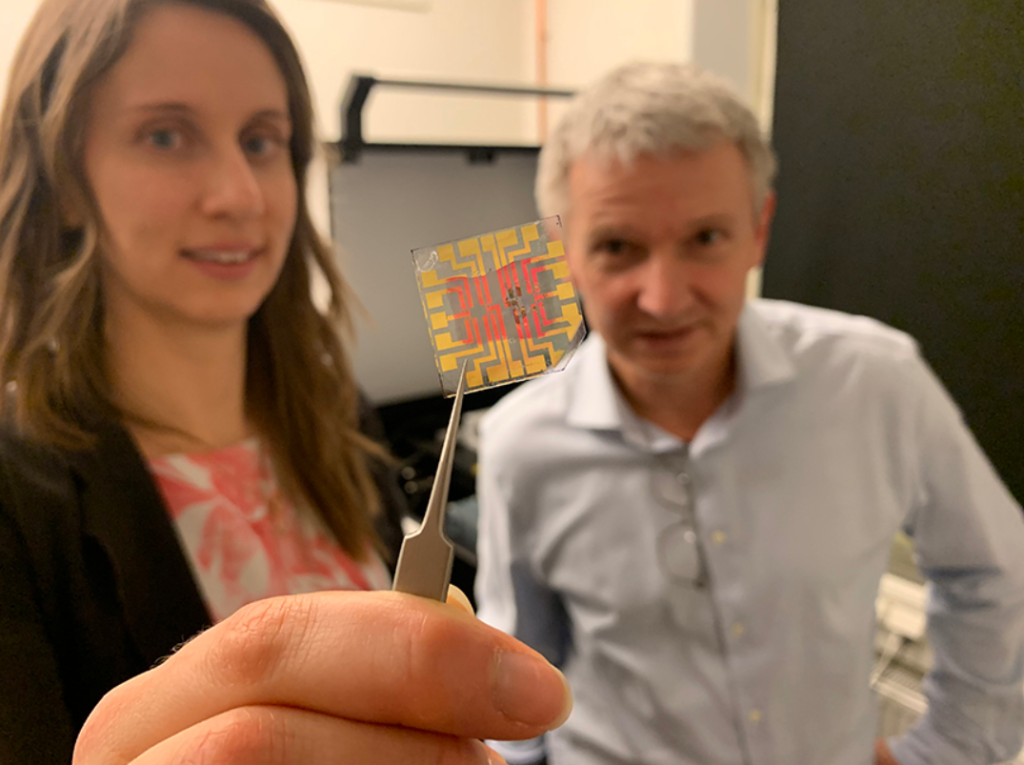Researchers from KTH Royal Institute of Technology and Stockholm University have introduced a novel method that streamlines the production of electrochemical transistors, utilizing a standard Nanoscribe 3D microprinter.
By hacking the 3D printer, the researchers were able to streamline the process by eliminating the need for specialized cleanroom environments and the use of solvents or chemicals, addressing key limitations associated with traditional fabrication processes. Professor Anna Herland, specializing in Micro- and Nanosystems at KTH, underscores the significance of this approach in expediting the prototyping of essential components for medical implants, wearable electronics, and biosensors.

Speeding up sustainable bioelectronic device fabrication
Published in the journal Advanced Science, the research showcases the successful fabrication of complementary inverters and enzymatic glucose sensors using the new method. According to Erica Zeglio, a co-author of the study and researcher at Digital Futures, this approach not only accelerates production but also offers a more sustainable alternative to conventional practices.
Polymers play a central role in various bioelectronic applications, from monitoring living tissues to facilitating disease diagnosis. The research team’s approach demonstrates enhanced efficiency and accessibility of these devices, potentially paving the way for broader adoption and utilization.
KTH Professor Frank Niklaus, another co-author of the study, highlighted the versatility of the method, which extends beyond electrochemical transistors to encompass other soft electronic devices. The successful application of ultrafast laser pulses enables rapid prototyping and scaling of microscale devices, presenting opportunities for further innovation in the field.
Professor Herland foresees a shortened time-to-market for bioelectronic devices and the incorporation of sustainable components, marking progress towards an environmentally conscious future in electronic device manufacturing. This vision indicates a positive step towards enhanced efficiency and environmental responsibility in the production of electronic devices.

Innovative 3D printed bioelectronics
Bioelectronics merges biology and electronics, creating devices that interact with biological systems. It spans medical implants, wearable monitors, neural interfaces, and biosensors, aiming to monitor, diagnose, or treat conditions while advancing our understanding of biology.
Away from KTH Royal Institute of Technology and Stockholm University, 3D printed bioelectronics developed by other entities have hit the headlines before. One example includes that of University of Houston scientists who developed a novel method of 3D printing bio-sensors using multiphoton lithography (MPL) to create biocompatible circuit boards layer-by-layer, paving the way for implantable bio-electronic devices. As per the researchers, MPL is hailed as “state-of-the-art” due to its high material versatility and accuracy.
The team developed a custom MPL resin, enabling precise 3D printing of bio-circuit boards with homogeneous properties. Testing demonstrated enhanced cell survival and attachment. The bio-sensors exhibited high stability and precision in detecting glucose levels, with ten times higher sensitivity than current monitors, potentially accelerating the development of cybernetic implants.
Back in 2020, Joshua Uzarski from the CCDC Soldier Center revealed to 3D Printing Industry that the U.S. Army was actively engaged in developing Cyberpunk-style bio-sensors. Discussing the potential of conformal 3D printing, Uzarski highlighted its application for rapidly fabricating microfluidic devices on biological surfaces like human skin. Reminiscent of those in Cyberpunk 2077, these devices aimed for battlefield deployment offering enhanced situational awareness and potential detection of biological threats. The method devised by Uzarski’s team allowed for flexible, contamination-free microfluidic structures and rapid prototyping.
What 3D printing trends do the industry leaders anticipate this year?
What does the Future of 3D printing hold for the next 10 years?
To stay up to date with the latest 3D printing news, don’t forget to subscribe to the 3D Printing Industry newsletter or follow us on Twitter, or like our page on Facebook.
While you’re here, why not subscribe to our Youtube channel? Featuring discussion, debriefs, video shorts, and webinar replays.
Are you looking for a job in the additive manufacturing industry? Visit 3D Printing Jobs for a selection of roles in the industry.
Featured image shows researchers Erica Zeglio, left, and Frank Niklaus show a transistor which they printed using a 3D microprinter. Photo via KTH Royal Institute of Technology.



